Xi’an City Wall is one of the oldest, largest and best-preserved city walls still existing in China. It was built during the reign of Emperor Zhu Yuanzhang of the Ming Dynasty as a solid military defense system. It fully demonstrates the characteristics of city wall architecture during the feudal society. Compared with the European architecture of the same period, the scale and history of Xi’an City Wall are equally remarkable. For instance, in 14th-century Europe, the Leaning Tower of Pisa (built in 1173 but still under construction in the 14th century) was renowned worldwide for its unique inclined design and exquisite craftsmanship, while Xi’an City Wall is famous for its grand scale and long history.

The scale of Xi’an City Wall
- Location: Around the city center of Xi’an(Xi’an Station is opposite to Shangde Gate)
- Length: 13.7 KM (8.5 miles)
- Height: 18 M
- Width: Top Width12—14 M,Bottom width 15—18 M
- Square: 11.32 Square kilometers
- When Was the Xi’an City Wall Built: 1370
- Features: Four Main Gates: Changle Gate(East Gate), Anding Gate(West Gate), Yongning Gate( South Gate), Anyuan Gate(North Gate),watchtowers, corner towers, parapets, and a moat.
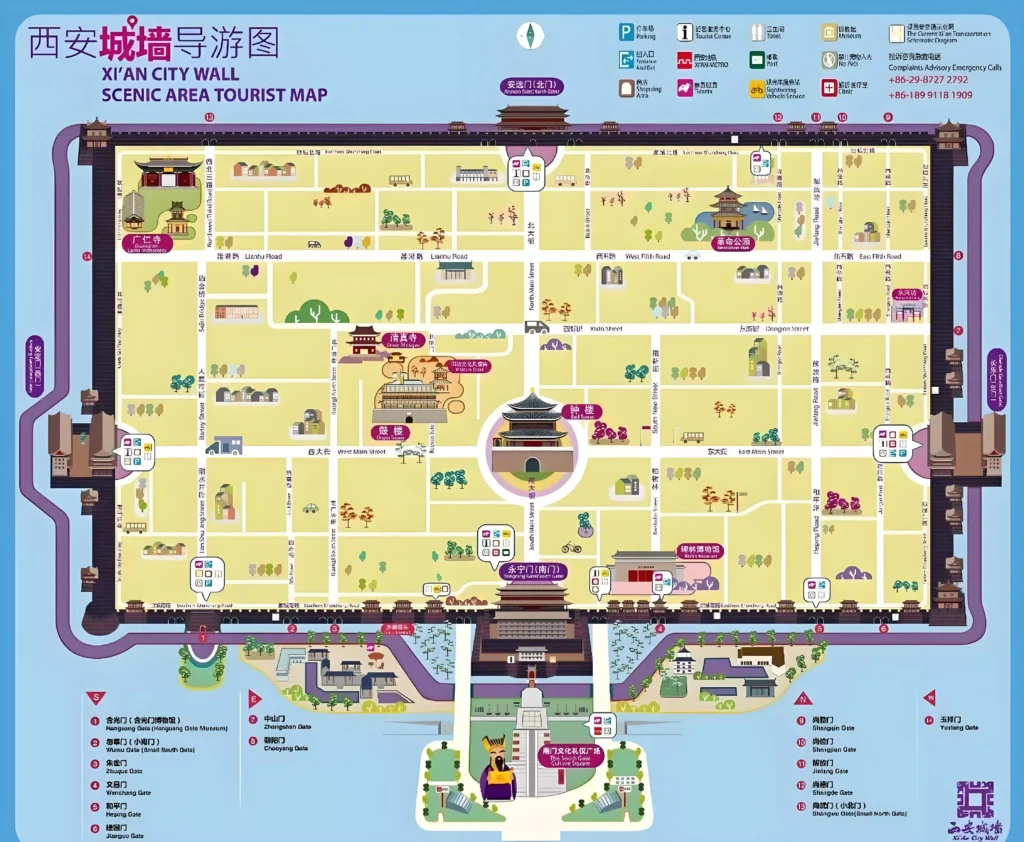
Four Main Gate
Since ancient weapons couldn’t easily break through thick city walls, attackers had to focus on the gates. This is why Xi’an’s wall built sophisticated multi-layered gate defenses (like archer towers and “kill zones”).
The wall has four main gates, each symbolizing a blessing:
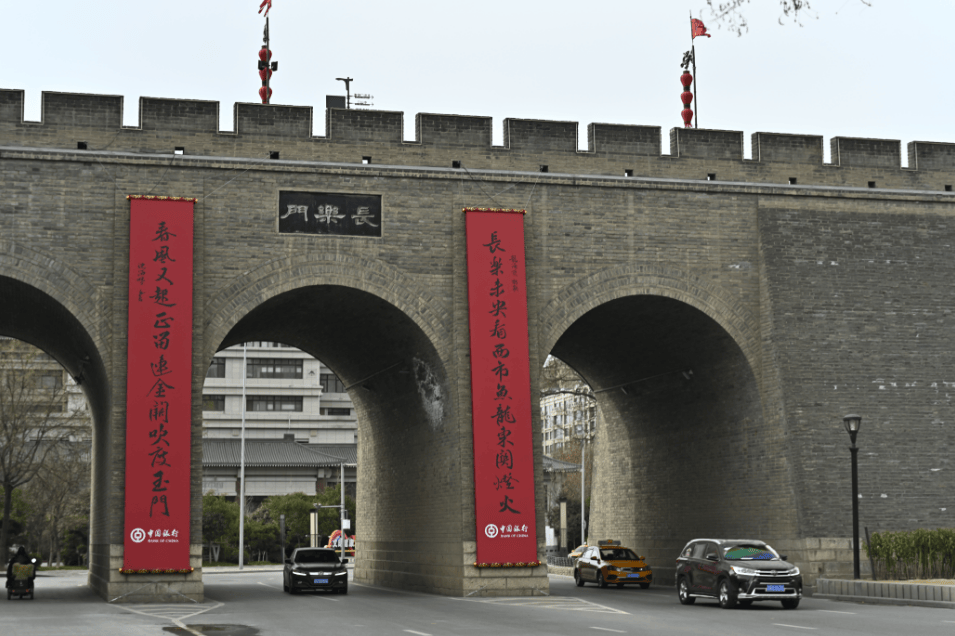
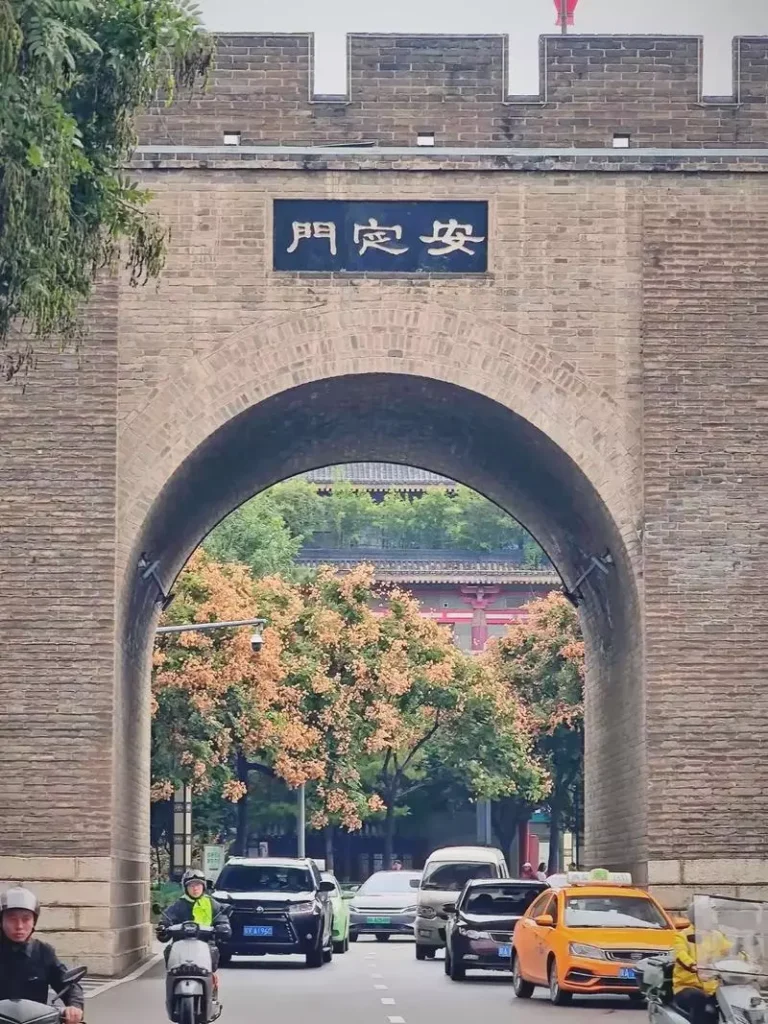
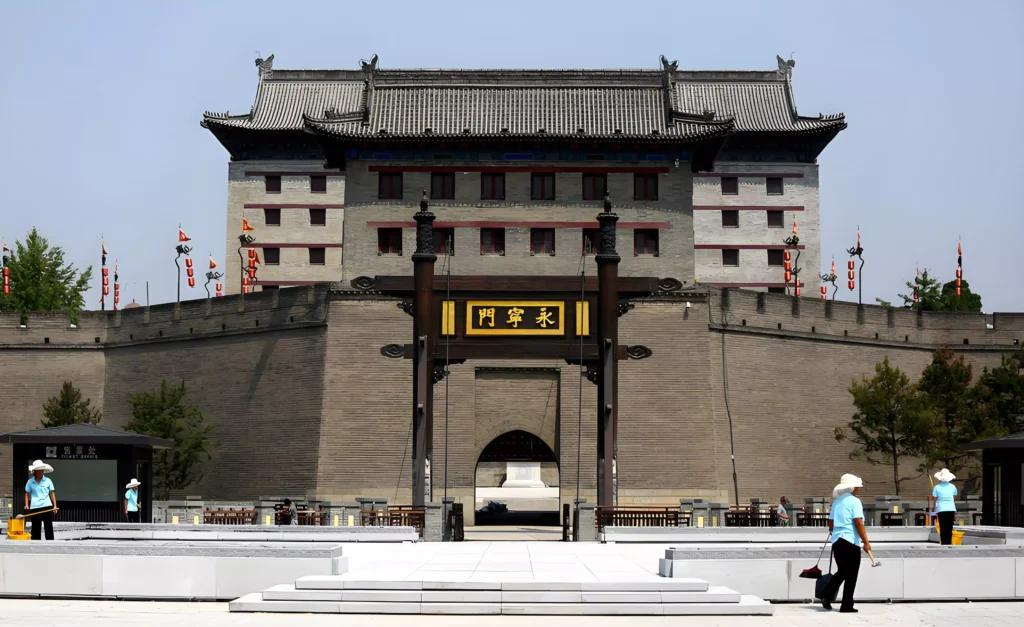
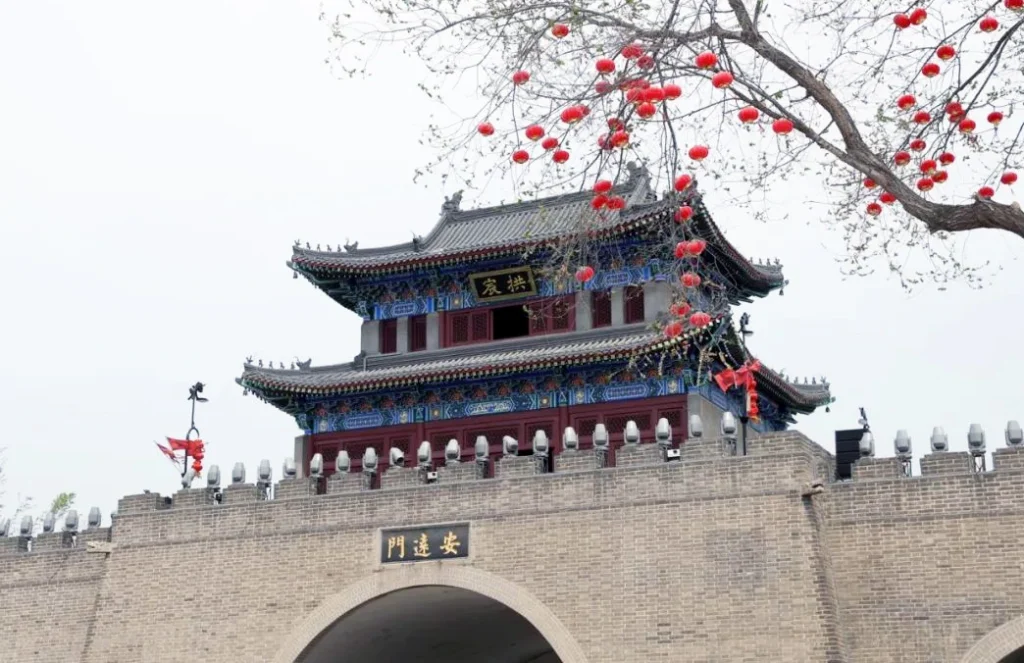
Today, the South Gate (Yongning) serves as the primary entrance for visitors to walk atop the ancient wall.The south gate, Yongning, is the most beautifully decorated one. It is very near to the Bell Tower, center of the city. Important greeting ceremonies are usually held in the south gate square.
If you come to visit the Xi’an City Wall, you must go to Yongning Gate. Why is that? Because climbing the city wall from Yongning Gate, you will be treated as a VIP; If you climb the city wall from other city gates, then you can only be considered an ordinary tourist!
Did you know? When foreign leaders visit Xi’an, they always enter through the Yongning Gate (South Gate). Why? Because this is the only place where you can experience the wall’s complete ancient defense system!
Here’s what you’ll see walking through Yongning Gate:
- cross a wooden drawbridge over the moat (protective water barrier).
- Enter the “Wengcheng” – a sealed courtyard trap between two walls.
- Pass under the Archer Tower – a fortress raining arrows on invaders.
- Go through the Gatehouse controlling the inner iron gate.
- Walk across the crescent-shaped outer yard (“Yuecheng”).
- Finally, under the Main Gate Tower, you enter the city!
At other gates, you can just climb the wall directly. But you’d miss this incredible 6-step “time travel” through ancient military genius!
Why the Xi’an City Wall Was Built
The expansion of the Xi’an city wall began in the seventh year of Hongwu (1374) and was completed in the eleventh year of Hongwu (1378), led by Geng Bingwen, Marquis of Changxing. The direct reason for this expansion is:
After Zhu Yuanzhang established his capital in Nanjing, he appointed his second son Zhu Zhong as the King of Qin and stationed him in the northwest. Xi’an became a key city for the Ming Dynasty’s northwest border defense and needed to strengthen its defenses;
The Sui and Tang dynasties’ Chang’an Imperial City (predecessor of the Xi’an City Wall) was relatively small in scale and could not meet the military needs of the Ming Dynasty. Therefore, it expanded northward and eastward, forming a city wall with a circumference of about 13.74 kilometers, laying the foundation for the existing pattern.
How Was the Wall Built
1. Main Construction Materials: Loess and Blue Bricks
Rammed Earth Core
The main body of the city wall was constructed using the **”layered ramming method”**. Loess mixed with a small amount of lime served as the raw material. Each layer was approximately 10–15 cm thick and compacted with wooden or stone rams, forming a solid rammed earth core. The base of the wall is 15–18 meters wide, while the top measures 12–14 meters in width.
Blue Brick Cladding
In the mid-Ming Dynasty, to enhance water resistance and defensive capabilities, the outer side of the wall was gradually clad with blue bricks (approximately 40 cm long, 20 cm wide, and 10 cm thick). Originally, the Tang Dynasty imperial city wall was only rammed earth. The blue bricks were bonded with **lime-glutinous rice mortar** (a mixture of lime, glutinous rice juice, and tung oil), which provided extremely high strength.
2. Auxiliary Materials and Techniques
Drainage System
The top surface of the wall features a slope of **5°–10°**. A “water tongue” (a stone drainage groove) is installed every 40–60 meters, directing rainwater into the moat below to prevent water seepage and collapse of the wall.
Defensive Construction Materials:
The wooden structures such as arrow towers and gate towers were mainly built using pine and cypress wood, which are both durable and resistant to decay.
The battlements and crenellations were constructed with blue bricks. Each crenel (the opening in the battlement) was approximately 1.8 meters high and 0.5 meters wide, providing cover for soldiers and allowing them to shoot arrows or firearms while staying protected.
The History of Xi’an City Wall
The Xi’an City Wall has a long history, with its origins dating back to the Sui and Tang Dynasties. In 582 AD, the Sui Dynasty built the city of Daxing. When the Tang Dynasty took over in 618 AD, they renamed it Chang’an. The first Tang Dynasty city walls were built around 654 AD.
In 904 AD (during the late Tang), General Han Jian rebuilt Chang’an. He kept and repaired only the imperial city section (the core administrative area), preserving its original Sui-Tang size and shape.
The wall as we see it today began to take shape under the Ming Dynasty. In 1370, Zhu Yuanzhang ordered the Marquis of Changxing, Geng Bingwen, and the Commander in Chief, Pu Ying, to oversee the construction of Xi’an city. During construction, the western and southern walls of the Tang Chang’an Imperial City were largely preserved, while the eastern and northern walls were expanded. The official construction of the city began in the seventh year of Hongwu (1374) and was completed in the eleventh year of Hongwu (1378), taking 8 years. The newly built city wall is 12 meters high, with a top width of 12-14 meters and a bottom width of 15-18 meters, with a total length of nearly 14 kilometers, forming the current scale and layout of Xi’an city wall.
Originally built of rammed earth, the wall suffered severe damage in a major earthquake in 1556. During repairs in 1568, Governor Zhang Zhi reinforced the entire structure with blue-grey bricks and also had a protective moat dug around it. Towards the end of the Ming Dynasty (early 1600s), four large defensive gate complexes were added to better resist rebel forces like those led by Li Zicheng.
A major restoration project was carried out in 1781 under Governor Bi Yuan during the Qing Dynasty. He ensured the wall, moat, and inner defensive ring functioned as a complete fortification system. Thanks to continuous maintenance over the centuries, it stands today as one of the largest and best-preserved ancient city walls in the world.
The Military Role of Xi’an City Wall
After its Ming Dynasty expansion, the Xi’an City Wall stands as a monumental feat of ancient engineering:
- Height: 12 meters (40 feet)
- Top Width: 12-14 meters (40-46 feet) – wide enough for troops and carts.
- Base Thickness: 15-18 meters (50-60 feet) – incredibly solid foundations.
- Total Length: 13.7 kilometers (8.5 miles)
- Outer Defense: Encircled by a deep, wide protective moat.
- The Brilliant “Rampart Bastions” (Mamian): Strategic Spacing: Originally, 98 massive rectangular bastions jutted out from the main wall, spaced precisely every 120 meters.
- Purpose: This design prevented attackers from safely scaling the walls and eliminated blind spots.
- Watchtowers (Dilou): Each bastion was topped with a watchtower. Soldiers could shelter inside, observe enemy movements, and fire arrows safely without being exposed.
- Crossfire Tactics: Crucially, the 120-meter spacing matched the effective range of ancient bows. This allowed defenders on adjacent bastions to rain down deadly crossfire on attackers caught between them – a devastating tactical advantage. Today 93 bastions remain. Sadly, only 24 still have their original watchtowers; the others were lost over time.
- Archer Tower (Jiànlóu):The Archer Tower (Jiànlóu) on Xi’an’s city wall sits directly above the main gate passage. Think of it as the ultimate defensive shield protecting the gate itself. If attackers tried to break down the gate with battering rams, climb ladders, or gather underneath it, soldiers inside the Archer Tower could shoot arrows straight down, drop heavy logs/stones, or pour scalding oil or quicklime (which causes terrible chemical burns) right onto them. This made attacking the gate extremely deadly.
Inside the tower, there was also the mechanism for a heavy iron-barred gate (like a portcullis) that could be dropped to instantly seal the passage. The tower protected the soldiers operating this heavy gate.
Defensive Features for Soldiers:
Outer Wall: Crowned with 5,948 crenellations (the classic up-and-down “teeth”). These provided shielded slots for soldiers to look out and shoot arrows.
Inner Wall: Featured a lower parapet wall (nüqiang) running along the walkway. This acted as a safety railing, preventing defenders from accidentally falling during patrols or combat.
A Testament to Ming Military Genius:
This entire system – the towering walls, the moat, the strategically placed bastions, the watchtowers, the crenellations, and the parapet – showcases the remarkable sophistication and ingenuity of Ming Dynasty military engineering. It stands not just as a wall, but as a powerful physical witness to China’s long history and the evolution of defensive architecture.
Things to Do on the Xi’an City Wall
Cycling the Wall: One of the most popular activities (rentals available);
If you want to cycle around the Wall, I recommend starting from the West Gate, North Gate, or East Gate. These three gates tend to have fewer tourists, making for a less crowded cycling experience.
The journey around the Wall takes approximately 1.5 hours.
Walking Tour: Best for taking photos and exploring the architecture
If you want to take a leisurely stroll and enjoy the scenery of the ancient city walls, we recommend starting from the South Gate (Yongning Gate), passing west through Zhuque Gate, and strolling along Zhuque Street.
Subsequently, you can visit the Han Guangmen Site Museum to see the Han Guangmen Site of the Tang Imperial City. This is the oldest surviving section of the Xi’an city wall, with the longest history and one of the best preserved Tang Dynasty city gate ruins to date.
This route takes about half an hour to walk and has moderate intensity, making it very suitable for the elderly and children.
Along the way, you will find a “horse face” (a pier protruding from the city wall) built approximately every 120 meters on the outer side of the city wall, with enemy towers (or corner towers) on top. Standing on these high points, you can not only overlook the scenery of the moat, but also see the daily activities of local residents such as dancing and practicing Tai Chi at the foot of the city wall.
Sunset Views: The wall at dusk offers beautiful panoramic views of old and modern Xi’an
Cultural Performances: Drum shows, lantern festivals during certain times
The opening hours of Xi’an City Wall
Opening Hours:
Peak Season (March – October)
Open: 8:00 AM – 10:00 PM
Last Admission: 9:30 PM (Ticket sales stop at this time)
Off-Season (November – February):
Open: 8:00 AM – 8:00 PM
Last Admission: 7:30 PM (Ticket sales stop at this time)
Important Notes on Gate Variations:
Longer Hours at Some Gates (Peak Season):
Gates including Yongningmen (South Gate) South Entrance, Yongningmen (South Gate) North Entrance, Wenchangmen, Wumumen (Small South Gate), Zhongshanmen (Small East Gate), and Jianguomen may stay open until 10:00 PM during peak season.
Earlier Closure at Some Gates (Off-Season):
Gates like Changlemen (East Gate), Andingmen (West Gate), and Anyuanmen (North Gate) may close around 8:00 PM during the off-season.
Ticket Price:Around 54 RMB (~$7.5 USD)
Entrance Points:South Gate is the most popular and tourist-friendly
Bike Rentals:
Single person bicycle
Rent: 45 yuan/vehicle (limited to 90 minutes)
Overtime fee: An additional 10 yuan will be charged every 30 minutes (less than 30 minutes will be counted as 30 minutes)
Deposit: 100 yuan/vehicle (refunded upon return)
Double bicycle
Rent: 90 yuan/vehicle (limited to 90 minutes)
Overtime fee: An additional 20 yuan will be charged every 30 minutes
Deposit: 200 yuan/vehicle
Rental location:
The south gate (Yongning Gate), west gate (Anding Gate), north gate (Anyuan Gate), and east gate (Changle Gate) on the city wall all have rental services.
Bicycles must be borrowed and returned in their original form (for example, renting a car from the south gate requires returning the bike from the south gate).
Accessibility: Elevators at some gates, but stairs still required in parts
When is the Best Time to Visit the Xi’an City Wall
Xi’an experiences significant temperature variations throughout the year, with distinct seasonal changes.
Spring and Autumn:People are widely regarded as the optimal seasons to visit the Xi’an City Wall, as the daytime temperatures remain consistently comfortable. During these periods, the highest temperature typically hovers around **25°C (77°F)**, creating an ideal climate for leisurely exploration.
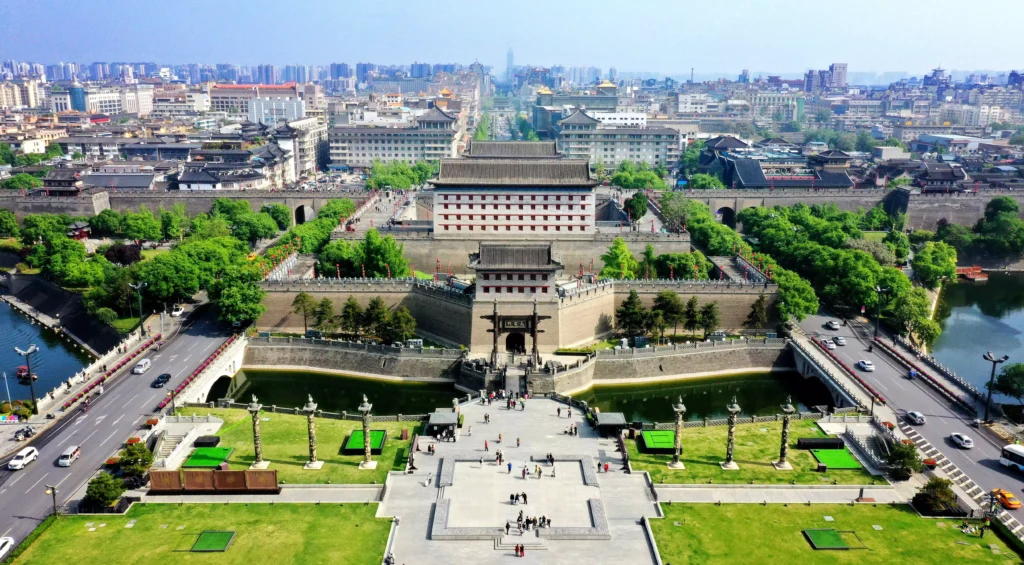
Summer : The morning hours from 8:00 am to 10:30 am are particularly recommended. With temperatures averaging 24°C (75°F), this timeframe offers a refreshing and pleasant atmosphere for walking or biking along the wall.
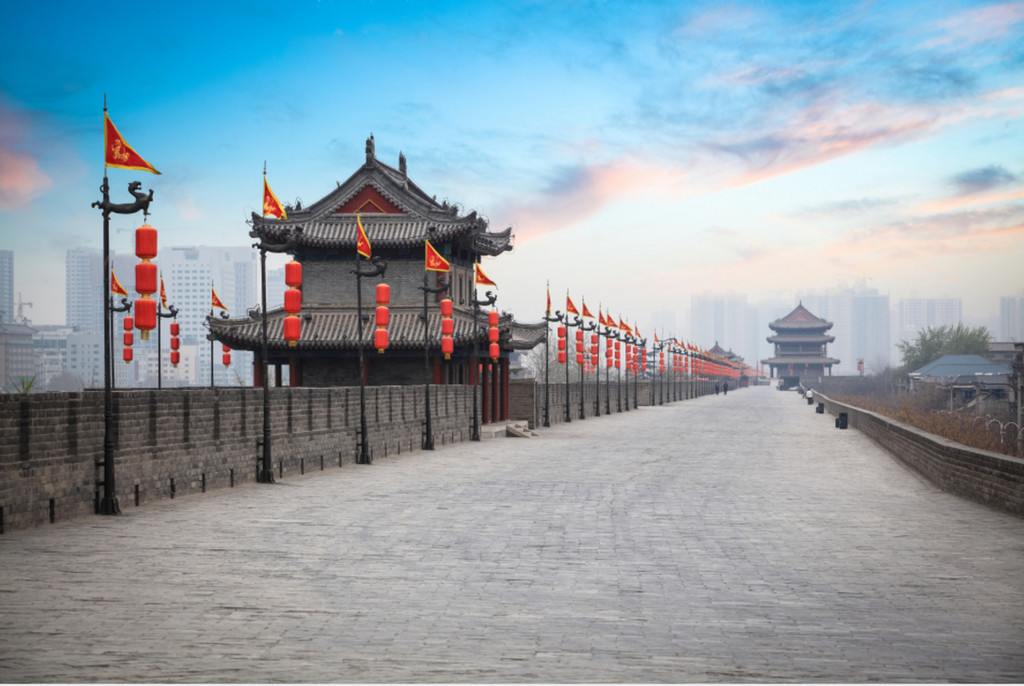
Winter: The most comfortable visiting window is in the afternoon, between 14:00 pm and 17:00 pm, when temperatures rise to approximately 7°C (45°F) This period provides milder conditions compared to the colder mornings and evenings.
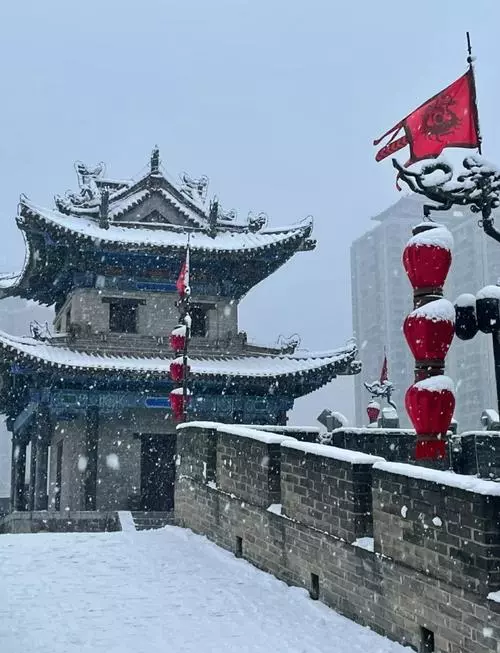
How to save money on visiting the Xi’an City Wall:
- Free Open Day (15th of each month): City Wall tickets are free, but bike rental still requires payment.
- Joint ticket discount: Some travel platforms offer “ticket+bicycle” packages, which are more cost-effective than purchasing separately on-site (saving about 10-20 yuan).
Why Xi‘an City Wall Matters: A Cultural and Historical Icon
The Xi’an City Wall stands as a powerful emblem of China’s enduring spirit and rich historical legacy. More than just a relic, it embodies the resilience of Xi’an itself. Built during the Ming Dynasty, it has weathered centuries of storms, wars, and dynastic changes. Yet, it stands tall and strong – a living heritage that silently narrates the city’s millennia-long story.
This ancient structure masterfully blends military ingenuity** with **architectural beauty**:
Its massive ramparts and sophisticated gateway defenses showcase the advanced engineering brilliance of ancient Chinese warfare.
Recognized as a National Key Cultural Relic, the Xi’an City Wall holds immense historical importance. It is:
- A priceless cultural treasure of the Chinese nation.
- One of the largest and best-preserved ancient city walls anywhere in the world.
- A magnificent testament to the glory of ancient Chinese architecture and the profound richness and depth of Chinese civilization.
